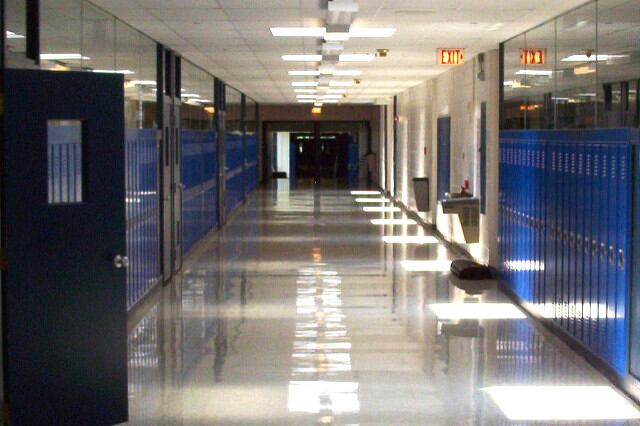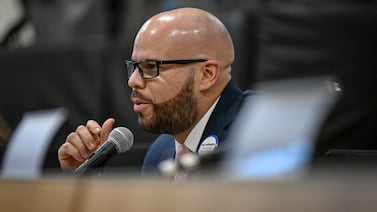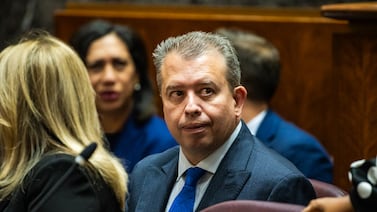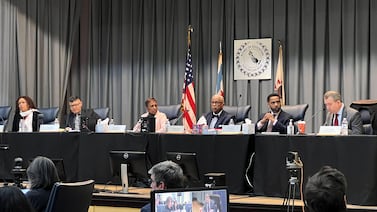This story was originally published by The Trace, a nonprofit which covers guns in America.
On a screen full of faces, the lone black square rang alarm bells for the Philadelphia teacher. The boy on the other side hadn’t turned on his camera and his microphone was muted. According to the rules for remote learning at John B. Stetson Charter School, the student was supposed to keep his laptop camera on during class. The teacher alerted Edwin Desamour, the dean at the middle school.
A few days later, during a meeting with the student and his mother, Desamour discovered that the 13-year-old student and his mother had been without a consistent home since the school reopened in late August. They’d been bouncing from space to space, staying with friends and family — and the student was keeping his camera off and staying quiet in class to avoid bothering his hosts. “The kid said, ‘I don’t want to make too much noise on the computer in someone else’s house,’” Desmamour explained. The boy had also figured that if other students couldn’t see he was relocating, they wouldn’t ask him about it. “He didn’t want kids to see that he was changing houses,” Desamour added.
The school had adopted uniforms so kids wouldn’t have to explain why they didn’t own the newest pair of jeans, but teachers hadn’t considered that students might feel judged for their backdrops during virtual classes. “Before, you got teased for clothes,” Desamour said, “and now it’s because a kid sees the background of your house.”
With school districts around the country operating remotely to avoid spreading COVID-19, teachers and administrators are confronting a full range of complications caused by virtual learning. In Philadelphia, educators have tried to address a specific challenge: When kids aren’t spending time in classrooms, it’s harder to keep them safe. Close to 1,450 people have already been shot in the city this year, eclipsing the total for all of 2019. The violence has taken an especially cruel toll on Philadelphia’s children. On the first day of classes for public schools, a quadruple shooting left two teens dead and two more wounded. Jaheim Lamarre and Zahquesz McFadden, both 17, were two of the 13 children killed by gun violence this year, and among the 111 children injured by gunfire.
Absenteeism spiked in many urban districts after schools abruptly switched to remote learning in the spring. Now, experts are worried that thousands of young people may again go without the benefits of the classroom during the new academic year.
Children learn critical emotional and social skills at school. “If we leave kids to their own devices, many of them are going to suffer,” said Anna Harvey, director of The Public Safety Lab at New York University. “Kids need a lot of adult support to thrive.”
“Physically being in school is protective, particularly for young men. It reduces the extent to which they become involved in violent incidents,” Harvey said. School places children under the supervision of adults and keeps them occupied for hours during which disputes might otherwise escalate.
The threat of gun violence was very much on Desamour’s mind when he counseled the student who was reluctant to turn on his camera. Stetson Charter School serves three neighborhoods in North Philadelphia. Forty percent of area residents live in poverty, compared to about 25 percent citywide. Those same neighborhoods have been the backdrop for much of the city’s violence. The three policing districts that closely overlap the neighborhoods served by Stetson account for 110 of the 335 homicides in the city this year, according to Philadelphia Police Department data. Rivalries between neighborhoods, and sometimes just an unfamiliar face on the block, can be a recipe for more violence.
Moving from one neighborhood to another can pose a threat to a child’s safety, Desamour said. Still, picking up on the cues that a child is moving and may be at risk is a challenge when school staff can’t see the student on screen. He and his staff insist that students keep their video switched on, partly so they can spot signs that a child may be at risk.
Outside of his duties as middle school dean, Desamour has spent the last decade working in street-level violence intervention. He uses what’s often categorized as the credible messenger model. Desamour was convicted in connection with a fatal shooting at 16 and spent eight years in prison. He says he served part of the stretch in the same cell as his father.
In Philadelphia, as in other cities, gun violence is highest during the summer months, and when in-person education slammed to a stop in March, “it felt like summer started early,” Desamour says. Desamour approached a local drug dealer who had recruited one of the teenage boys he mentors. At first, he says, the boy was just transporting drugs, but he was soon asked to look out for rival crews, and to fend them off with a gun if needed. Desamour was able to convince the dealer, a man who knows Desamour’s background, to leave the boy alone. But as the pandemic has choked off jobs in the city, dealers have found it easier to enlist new workers, Desamour says. “We were struggling to keep a hold on the kids.”
When COVID struck Philadelphia, it complicated all the city’s struggles — its pre-existing conditions. The School District of Philadelphia teaches more than 200,000 students, and officials say that gun violence has touched almost all of them. “They know someone in the family or someone in the community who has been shot or killed,” said Jayme Banks, the district’s director of Trauma-Informed School Practices. As they prepared to resume classes, administrators realized that they had to contend with the murders and nonfatal shootings that had surged in its wake. “We couldn’t open school and act like this hadn’t occurred,” Banks said.
During the summer, Banks and the district’s mental health staff began preparing to provide remote support for children emotionally wounded by the violence on the street. The district named its plan “Healing Together.” One of its central components was to train teachers how to spot children who might be dealing with a crisis.
In addition to their regular classes, students’ weekly schedules now include a 30-minute block that essentially functions as group therapy. Teachers ask the kids to respond to prompts that are designed to reveal things about their well-being without being too intrusive or embarrassing them in front of their peers. It can be as simple as describing their day or something they’re looking forward to. As the students give their responses, the teachers scan for indications of trauma or stress occurring off-screen. “Teachers can look and see the kid slipping through the cracks. They will look at their expressions. They will look at participation — someone, for example, who is in their favorite class, but is not showing their face,” Banks said.
Like many aspects of the U.S. response to the COVID-19 crisis, schools have approached trauma needs in a piecemeal fashion. Local districts act with great autonomy in how they teach, grade, and administer discipline; behavioral health is no exception. Early in the pandemic, while governors were ordering classrooms to close, few states provided specific guidance on how to handle the behavioral health services that are often provided on school grounds. In the districts that contract with private providers rather than employ their own social workers, it wasn’t clear if those third-party firms could even bill for video-conferencing sessions that felt dramatically different from the in-person therapy for which they were hired.
“This is a stress test on how our education system does big responses,” said Michael Kelly, a board member of the School Social Work Association of America. “And it’s been a wake-up call that those capabilities aren’t there.”
Philadelphia’s public schools have social workers on staff, paid for through federal Medicaid funding that the district long ago earmarked for this purpose. Going into the current academic year, the district added social workers so that each campus would have a social worker assigned to it. Still, virtual counseling is an imperfect substitute for the person-to-person interactions that happen during normal schooling.
“When a kid comes through the door, you know something’s off,” Desamour said. “We can do preventive things before this kid explodes. A lot of times, the kids won’t initiate the contact, you have to recognize it and reach out. But online, it’s hard to capture those things.”
The pandemic has also compromised some of the privacy that schools could offer when students needed help. Where does a child go to talk about problems at home, when they are at home? “The kids don’t know who is listening, and they will sometimes say, ‘I don’t want to talk about that because my mom is here or my brother might hear me,’” Kelly said.
Most worrisome are the students who have fallen out of touch with the school system. The district estimates that 18,000 homes where its students live are not connected to the internet. Similar technology gaps have exacerbated the inequities of remote learning in other cities. And then there are occurrences that school officials across the country didn’t imagine. In Washington, D.C., smoke alarms have routinely interrupted online classes, leading the Fire Department to launch a citywide push to remind families to replace the batteries in their smoke detectors.
Philadelphia schools don’t expect to hold in-person classes until mid-November, at the earliest. Until then, Desamour and his teachers and social workers are masking up and walking through the neighborhoods where his students live, bringing help to students and families who’ve shown signs they may need it. And they are finding at least one silver lining.
School buildings can be intimidating places for parents in poor communities, Desamour says: “They are thinking that at the school there are all these smart people. They don’t give themselves enough credit and speak up for themselves or their kids.” When a meeting happens at the kitchen table or on a stoop, the dynamic shifts. Parents open up and talk more — and teachers and social workers get a better feel for their students’ lives.
“We are all in the predicament where we have to talk to each other now,” Desamour said. “We should have been talking before, but now we have to.”





